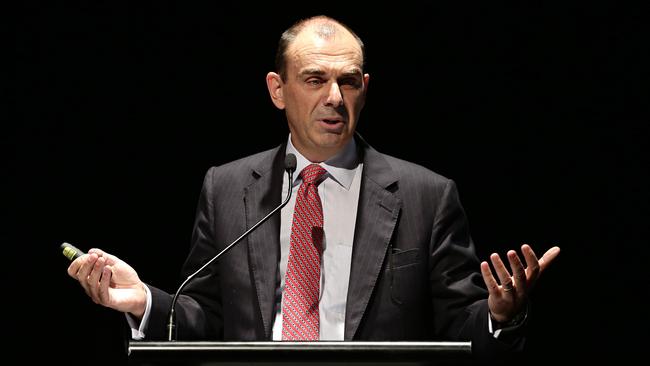Questions over APRA, RBA quest for ‘unquestionably strong’ banks
You could conclude from this week’s pronouncements that our banking and monetary regulators know what they are doing.

You could conclude from this week’s pronouncements that our banking and monetary regulators know what they are doing; that the hands on the tiller of Australian finance are both firm and wise. If you did, you might be wrong.
APRA has decreed that from 2020 Australia’s banks will be geared 9.5 times instead of 10.5 times. What a relief: that’ll make all the difference when the manure hits the fan.
Actually, ANZ is already there and the others are almost there, so it will make little or no difference, and won’t change when the Basel boffins tighten risk weightings.
Meanwhile the Reserve Bank board has mumbled that 3.5 per cent might be the neutral cash rate (actually they were proposing that the neutral rate had fallen, but it was taken, including by none other than the Prime Minister, as foreshadowing hikes).
In fact, neither of our credit supervisors has much of a clue at all about what they are doing, simply because the outcome is unknowable.
Both APRA and the RBA seek an intangible grail called “unquestionably strong”: that is, an unquestionably strong banking system and an equally strong economy, although the word “unquestionably” is now covered by APRA patents and is off limits for central bankers.
“Unquestionably strong” is a quasi-religious chant originally sung by David Murray’s Financial System Inquiry in 2014. The refrain has since been eagerly picked up by the monks at APRA.
Will 150 theoretical basis points of extra hypothetical capital (in practice, almost none) make the banks strong enough to unquestionably withstand a property apocalypse? Who knows.
And will 200 basis points on the cash rate eventually produce stable inflation and low unemployment? Maybe, in theory, but no one really knows. At least the RBA knows it doesn’t know. After estimating the neutral nominal cash rate at 3.5 per cent, the minutes released on Tuesday went on to say: “There is significant uncertainty around this estimate.”
No such feebleness for the fierce friars at the bank regulator. This week’s press release, headed “APRA announces unquestionably strong capital benchmarks”, firmly intones: “APRA has concluded that it is necessary to raise minimum capital requirements by around 150 basis points from current levels to achieve capital ratios that would be consistent with the goal of ‘unquestionably strong’.”
It then goes on to acknowledge that most of the banks are already there and won’t “need to raise any additional capital”.
To sum up then: the RBA has tentatively, uncertainly foreshadowed the doubling of interest rates, while APRA has emphatically announced … nothing. And none of it happens for years anyway.
Meanwhile the banks may or may not be unquestionably strong, having spent the past few years lending like drunkards to property speculators.
Will the reduction in their gearing since Murray’s inquiry from 12 times to 10 times be enough to prevent a run on them if things go south in the property market?
Of course not. It’s pure window dressing, designed for good times, not bad. The true bulwark for the bad times is that each of the big four is too big to fail and will be bailed out by taxpayers, as they were in 2008. Nothing has changed on that score since then.
The economy, meanwhile, does look strongish, especially after Thursday’s employment numbers, but not unquestionably so.
Like the banking system, output and employment are vulnerable to a property collapse plus a full range of other things: energy prices, China, drought, Trump, China, and a rapid return to the neutral cash rate, to name a few.
In some ways, the confidence and decisiveness of APRA, in contrast to the careful tentativeness of the RBA, has resulted in the bank regulator virtually taking over monetary policy.
Since Murray gave APRA a new set of dentures, the gap between the cash rate and standard variable mortgage rate has doubled from 2 per cent to 4 per cent. In other words, APRA has had more impact on what the banks charge for credit, and therefore actual monetary policy, than the central bank.
This week’s RBA minutes, and the discussion of the neutral cash rate therein, looks like a signal that control of monetary policy is about to be wrestled back.
APRA appears to be at ease now. Its press release concludes: “In combination, the increases outlined in the information paper will complete a significant strengthening of risk-based capital ratios within the Australian banking system in recent years.” Complete.
The RBA is at rest as well. Rates can’t be cut for fear of fuelling another leg of the property boom and they can’t be raised for fear of choking off the employment recovery through a spike in the exchange rate. In truth, APRA and the RBA have outsourced monetary policy to Janet Yellen and the Federal Reserve. The key to the Australian economy is now the exchange rate, and that is all about the US dollar.
Alan Kohler is publisher of The Constant Investor.



To join the conversation, please log in. Don't have an account? Register
Join the conversation, you are commenting as Logout